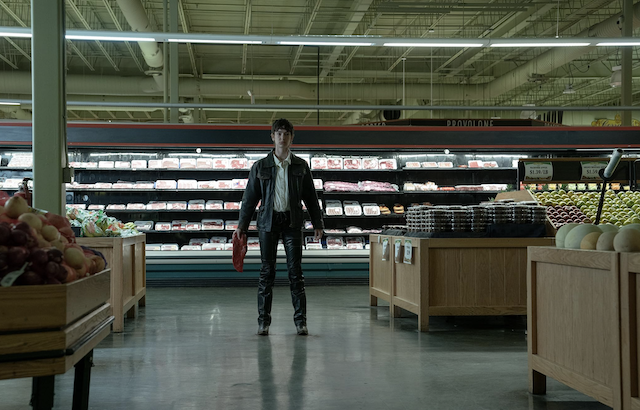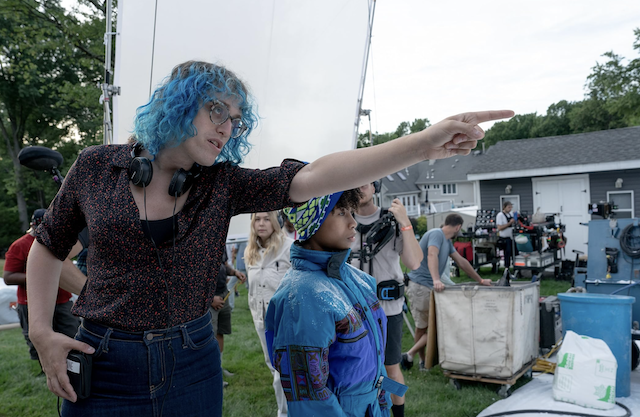
©Courtesy of A24
Youthful self-discovery is a gripping, emotional and often times painful journey that can lead to a multitude of results. For those teens who feel alienated from their families and peers, they often use media as a coping mechanism to help them find their place in the world. That’s certainly the case for the main characters in the new psychological horror film, I Saw the TV Glow.
The movie’s writer-director, Jane Schoenbrun, has a lot to say about the role of pop culture in adolescence and the dangers of holding onto it. Much like their previous feature, the acclaimed 2021 coming-of-age psychological horror film, We’re All Going to the World’s Fair, their new project explores how denial of self can be painful, especially when influenced by pop culture.
I Saw the TV Glow follows Owen (played first by Ian Foreman and then by Justice Smith) and Maddy (Brigette Lundy-Paine), two devoted fans of The Pink Opaque, a 1990s YA monster-fighting, adventure-fantasy television series that embraces inspiration from Buffy the Vampire Slayer. Owen is interested in exploring the show, but his overprotective parents forbid him from watching it, partially because it airs late at night.

©Courtesy of A24
So when Owen discovers that his classmate Maddy, a loner who’s two years older than him, is also a fan of the series, the duo quickly form a bond, despite both of their hesitations to form new friendships. But she records new episodes of the series on VHS tapes for him and gives them to him at school.
The two bond over the show every week, despite having little else in common, except for living on the fringes of their high school norms. Maddy embraces being gay, and as a result, knows herself a bit better than the socially apprehensive Owen. But The Pink Opaque brings them together, as it reflects their defiantly held differences and offers them something to focus on in their otherwise elusive adolescence. The show thus consumes their entire existences.
The show continues to live inside the two teens, and perhaps the other way round, long after its cancellation and the duo finish high school. Unable to cope with her family life, Maddy eventually decides to leave their small town for years. Her absence leaves Owen to negotiate adulthood on his own, as he contemplates why she left, with only his now-dated appreciation of the series to define and support him.
The character-driven element of I Saw the TV Glow, on which Emma Stone served as a producer, make it as affecting and grounded as We’re All Going to the World’s Fair. Both movies thrive on the idea that in real life, teenagers often look for representations of themselves in media, and connect with other people who gravitate to the same fiction.
The tense, tacit bond between Owen and Maddy, who are both highly guarded, grows over their passion for The Pink Opaque. Smith and Lundy-Paine naturally build their characters’ connection on screen by giving fragile, volatile performances as introverted people.

©Courtesy of A24
The actors highlight how their characters are certain that there isn’t any place in society that will make them feel as accepted as their televisions. The two lead characters are struggling teenagers who are often looking for representations of themselves wherever they can, and their televisions do just that.
I Saw the TV Glow thrives in creating characters whose identities reach beyond conformist social standards. With Schoenbrun stunningly championing their trans and nonbinary identity, the drama serves as as a metaphor for gender dysphoria through its protagonists. While Owen refuses to examine his true personality throughout his adolescence and adulthood, Maddy is more willing to discuss the fact that she’s gay and nonbinary.
The characters’ differences in accepting their true selves is powerfully showcased when Maddy asks Owen during a crucial scene in the drama, “Do you ever feel like you’re narrating your own life – watching it play in front of you like an episode of television?” Schoenbrun’s scribing abilities in that scene highlights how Maddy is talking about a specific kind of dissociative state that many trans people experience: dysphoria, a feeling that something is wrong but that words can’t describe.
This is seen throughout the film when Owen repeatedly addresses the camera to narrate his own life. In both content and structure, Owen’s ability to trust himself is called into question.
Owen is a flawed, deeply relatable character who’s rarely showcased in movies. Schoenbrun has described the character as essentially being a trans woman who’s unable to acknowledge or act on the knowledge of what makes him special, despite coming close several times throughout life.
Owen never fully connected to himself, especially since he suffers from anxiety. Unlike many other films that track a character over decades, Owen never truly emotionally grows or becomes more grounded; he’s instead trapped in his adolescent mindset, and is out of touch with himself throughout his adulthood.

©Courtesy of A24
While Smith plays Owen in various periods in his life, beginning in his late teen years and going into middle age, it’s the final era that best allows the actor show off the physicality he brings to the role. The performer highlights his character’s increasing separation between his mind and body through his increasingly rigid movements.
Like Schoenbrun, Lundy-Paine is also non-binary, which allowed them to accept their character’s true self in a more comfortable, freeing way than Smith was with Owen. The filmmaker and performer’s shared experiences allowed them to explore Maddy‘s queer experiences in complex ways that haven’t been seen in movies before.
As a result, Lundy-Paine embraced Schoenbrun’s intention to initially show Maddy as being completely absorbed in The Pink Opaque because it doesn’t represent her real life. She has a difficult home life, including dealing with a lot of loneliness, but doesn’t appear that way to Owen; she instead becomes a symbol of freedom, and becomes the one who has to try to save him.
Schoenbrun proved their versatility as a filmmaker by emphasizing the reasons why people choose to find solace online in the modern day throughout We’re All Going to the World’s Fair. Meanwhile I Saw the TV Glow explores the experience of seeking a sense of self through analog fandoms and ’90s television series. The mass culture that teens experienced in the ’90s, like Owen and Maddy felt with The Pink Opaque, is making them ponder their self-recognition and self-denial in the current day as adults.
As the duo grows older, they realize that such fandom became a mode of dissociation for them, as they tried to contend with their own lives. The drama’s protagonists, like viewers of that generation, are now left reassessing the realities of their youths.
Schoenbrun’s journey of exploring ’90s young adult media is also reflected in the actual visual components of I Saw the TV Glow, particularly through The Pink Opaque. The film’s production designer, Brandon Tonner-Connolly, and costume designer, Rachel Dainer-Best, made their respective visuals stylized and campy without making them over-the-top.
Eric Yue’s cinematography in the movie also corresponds with the look of the feature’s production and costume design. He differentiates the events seen in The Pink Opaque from I Saw the TV Glow‘s narrative through suitably glitchy, pre-digital VHS-level visuals. That style uniquely sets itself apart from the iridescent neon depths of his 35mm lensing for the movie’s narrative.
I Saw the TV Glow is a thoughtful, original exploration into adolescence that allows all teens to embrace their self-identity. Schoenbrun proved they’re becoming one of the most singular American filmmakers of the current generation by offering an uncompromising new vision in queer and trans cinema.
I Saw the TV Glow is now playing in U.S. theaters, courtesy of A24.
Grade: A-
If you liked this article, please share your comment below.
Check out more of Karen Benardello’s articles.
Here’s the trailer of the film.

